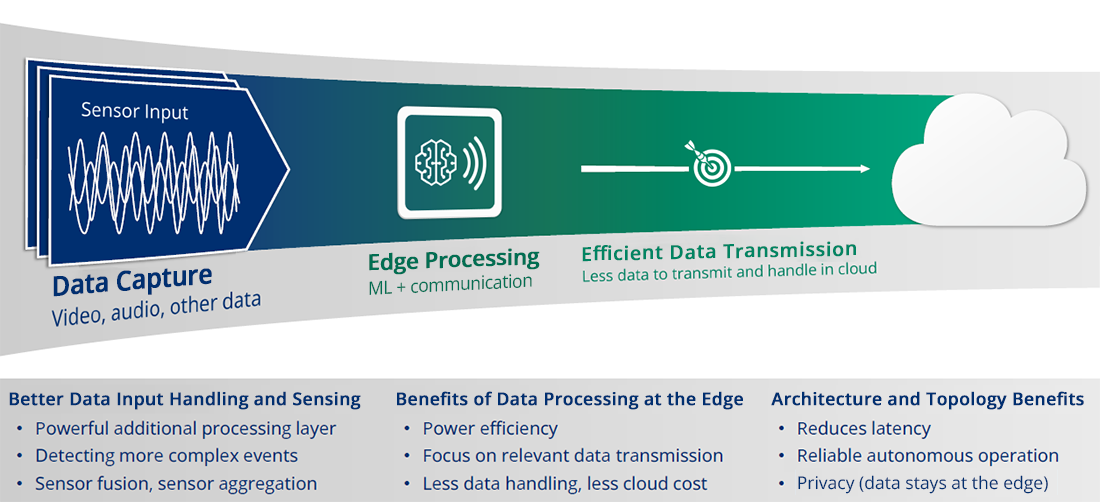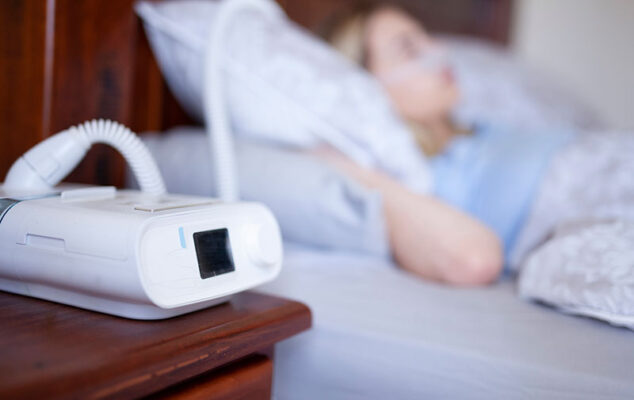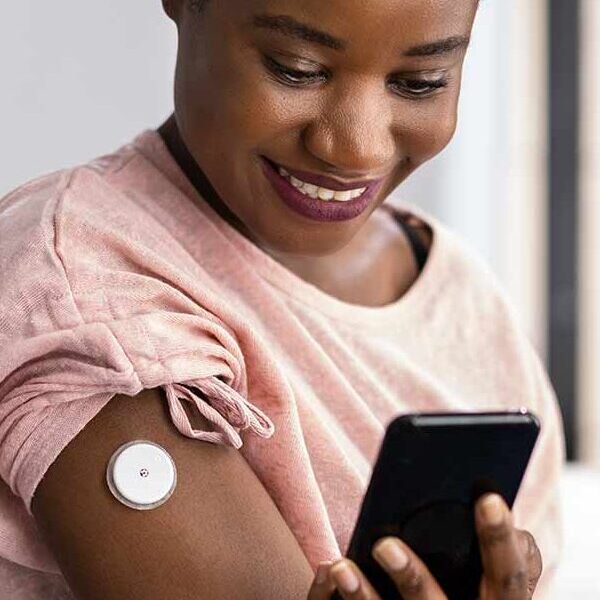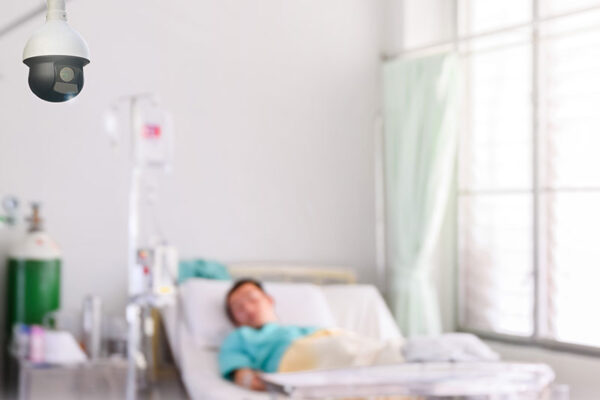Edge AI in Connected Health Care: Meet People Where They Are
By Bill Dykas
March 25, 2025
By Bill Dykas
March 25, 2025
Estimated reading time: 11 minutes
The connected health care industry has made considerable progress, with a patient-centered approach driving technology and advancements. Berg Insight projects that connected home medical devices will reach 126 million by 2027.
Quickly emerging in this mix is edge artificial intelligence (AI). It refers to combining edge computing and AI to execute machine learning (ML) tasks on edge devices. Edge AI takes health care — especially outpatient care — to a new level.

Challenges in health care are growing at an alarming rate. Besides an aging population, chronic diseases are one of the key drivers. The National Library of Medicine estimates that the global cost of chronic disease will reach $47 trillion by 2030. Patient overload, medical staff shortages, and burnout further complicate the health system.
“People want on-demand health care with greater accessibility to real-time answers. COVID has been the tipping point for the demand for telehealth. We are receiving feedback from physicians that they are building better relationships with patients and seeing greater uptick in usage by older adults.”
— Jisella Veath Dolan, Chief Global Advocacy Officer, Honor + Home Instead
Connected health is a holistic solution for improving the health care ecosystem. It opens the doors to greater accessibility and real-time answers that people want.
This ecosystem integrates patients and providers along with data from connected medical devices.

Internet of Things (IoT) medical devices use sensors to:
Connectivity is a key component. Many smart devices like trackers depend on Wi-Fi or Bluetooth® wireless technology to connect to the cloud and send and receive data. However, they must be within range of a cellular phone, internet router or gateway, which can present connection challenges.
In remote settings, cellular IoT may be a better alternative to connect these devices to the cloud. Still, devices supporting cellular connectivity require certifications and regulatory approval. It also consumes more power. Patients need to monitor battery life to avoid disruptions.
Many use cases benefit from a hybrid model, combining the strengths of multiple protocols. Platforms like the cloud process, analyze and share the data with care providers. Although cloud-based processing and cloud AI have gained traction over the last decade, there are limitations.
Always-on connectivity is vital for acute health emergencies and for enabling critical home care services. For patients with poor or unstable internet, getting timely access to care is challenging, especially in emergencies.
Transmitting patient data from devices to cloud platforms is powerful. However, it can cause delays in data transfer and lost connections. Security and privacy risks are also a concern as the data travels over the network.
Another obstacle is bandwidth. Massive growth in IoT devices significantly increases the amount of data they generate. Data centers and private clouds can be overwhelmed with managing and storing that data. Excessive bandwidth usage can also lead to network congestion, resulting in slower speeds and latency issues.
There are many limitations to consider. To resolve these challenges, edge AI with the right connectivity is becoming a game-changer in connected health care.

What is edge AI in connected health?
Edge AI combines edge computing with intelligence from AI and ML. Edge computing enables relevant data storage closer to where IoT devices and sensors generate it. It could be remote patient therapy devices, such as:
AI applications provide real-time insights. AI algorithms allow critical data to be processed and analyzed on the network edge near or on the device. It is independent of internet access. As a result, data is analyzed in real time and decisions are made at the point of care without delays.
In connected health, ML is an application of AI. It identifies and learns a patient’s patterns, such as vital signs or movements. By learning daily patterns and identifying changes, ML increases the accuracy of the output with faster decision-making.
The medical device with edge AI collects, instantly processes and uses data. For instance, this IoT device can:
Without edge AI, companies store data in a central database server like the cloud. The connected devices must wait for data to be transferred to and from the cloud. Large amounts of incoming data can overwhelm the centralized model. It also needs AI and ML for real-time processing.
Edge AI for IoT devices has several benefits in patient-centered health care. Here are four key advantages in creating a positive patient experience:
Processing data on or near the device enables quicker clinical decisions and interventions. Real-time responses without delays are critical in emergencies.
Patients no longer have to rely on high-speed internet or wireless Bluetooth technology.
Processing data locally means quicker responses are available for health care providers and patients than with cloud-based workflows.
AI can leverage ML models to analyze vast amounts of data at the remote point of care accurately.
Overall, edge AI is faster and more dependable. Since data is not sent back and forth over networks, processing times are shorter, and data is more secure.
Only actionable insights derived from local data processing are transmitted to the cloud. This ensures that no raw patient data is transferred. As a result, the patient receives more personalized, real-time treatment with better outcomes.

There is one more critical component of seamless connected health care. Edge AI and IoT devices need secure and reliable connectivity.
A gap currently exists in connectivity. Most solutions are developed for smartphones with Android™ or Apple enabled by Bluetooth wireless technology. While both have their benefits, it’s not accessible to everyone. People without reliable, affordable, high-speed internet or those new to connected devices can find it overwhelming.
Cellular 4G and 5G networks are fully authenticated and cybersecure. They require less effort on the participants’ part without worrying about connection setup. Furthermore, 4G and 5G connected medical devices can connect directly to cloud systems. This allows them to comply with the often required national or regional sovereignty for patient data.
Cellular-enabled, user-friendly tools empower patients to adhere to health tracking devices. For instance, Fitbits showed increased activity in hemophilia patients post-treatment. Such connected devices provide higher-quality data on monitoring, behavior and adherence than previously possible.
Edge AI, IoT medical devices and cellular connectivity meet the top three needs in connected health care:
Moreover, they enable personalized, proactive patient care without overburdening providers. These solutions can significantly cut health care costs for all stakeholders by facilitating early interventions and reducing hospital visits.
Market.us projects that the edge AI market will reach $143.6 billion by 2032. This is a jump from its value of $19.1 billion in 2023.
Five factors behind this growth are:
Edge AI and IoT medical devices are elevating heath care in outpatient monitoring and critical home care.
Edge AI is ushering in a new era of IoT adoption in health care and revolutionizing the patient experience. Secure 4G and 5G mobile connectivity between edge AI-controlled medical devices and health care providers enable new use cases.
These are three emerging applications for remote patient monitoring. Edge AI and IoT platforms make them a viable option.

Cloud-based Object Tracking and Behavior Identification System (COTBIS) is a smart health care video surveillance system. It uses IoT technology and edge computing at gateways. In addition, COTBIS enables intelligent video analytics on edge devices.
Background subtraction and deep learning algorithms can find unusual behavior patterns and activities. For example, they can track a patient’s movement in bed. The system uses reliable 4G and 5G connectivity to alert caregivers if it detects unusual movements. Predicting fall behaviors is also more accurate.
COTBIS minimizes network bandwidth and response times between wireless cameras and cloud servers.

Vital sign data from assessments is critical in determining the care a patient will need. The appropriate treatment is key in preventing patient health deterioration.
Hospitals often acquire patient vital signs data manually with centralized smart devices. This data is stored in the cloud or on spreadsheets, making it challenging for doctors to use.
IoT, Internet of Medical Things (IoMT), AI and ML offer a distributed intelligent platform. It interconnects medical devices and integrates data from various sources. Proper storage and easy access to personal health records can enhance diagnosis and patient health monitoring.
Beyond vitals like heart rate, edge AI and IoT devices with body-worn sensors can collect holistic data, including:
This enables accurate monitoring and a comprehensive patient view. If readings deviate from norms, the devices can promptly trigger alarms to notify the care team.
Falling can cause severe injury and death in older populations. Rapid detection, response and treatment can improve outcomes. However, most falls occur away from caregivers. Robotic systems could be the answer to detect and respond to falls.
A prototype system is being evaluated. It integrates an intelligent humanoid robot, Robot EUREKA, with an ML neural network classifier. The robot is trained on sensor data from a mobile device.
EUREKA accurately and reliably detects falls in real time. It can instantly alert care givers while providing real-time patient monitoring and interaction through the robot. Ongoing work will add capabilities like robotic vision to:
These are just a few emerging application advancements using edge AI and IoT medical devices and connectivity.
Edge AI and connected health care have opened new opportunities that fulfill needs in new ways. A partnership between Telit Cinterion and Alif Semiconductor resulted in creating one of the latest developments.
Alif Semiconductor supplies the most secure, power-efficient microcontrollers (MCUs) and fusion processors enabled by edge AI. With Telit Cinterion, the company developed the Vision AppKit. It’s the world’s smartest and most efficient ultracompact camera design the size of a postage stamp.
The Vision AppKit is an ultralow-power, AI-enabled camera reference design. It captures images and video and performs AI-based processing in real-time. Then, it delivers the results wirelessly to a display or other external system using significantly less power.
Vision AppKit uses Alif’s E3 Series MCU to power the camera and enable edge AI capabilities.
Telit Cinterion supports communication with modules, including:
This technology enables battery-powered cameras to execute computations that were once only possible in the cloud.
Edge AI, IoT devices and cellular connectivity enable personalized, proactive patient care without overburdening providers and resources. Facilitating early interventions and reducing hospital visits can cut health care costs for all stakeholders and enhance care.
Telit Cinterion has over 30 years of knowledge and experience in the IoT space. We have the most secure, reliable technology and connectivity. We can help you meet evolving regulations and deliver top-quality patient care.
Speak with a Telit Cinterion expert for more information on connected health care with edge AI.